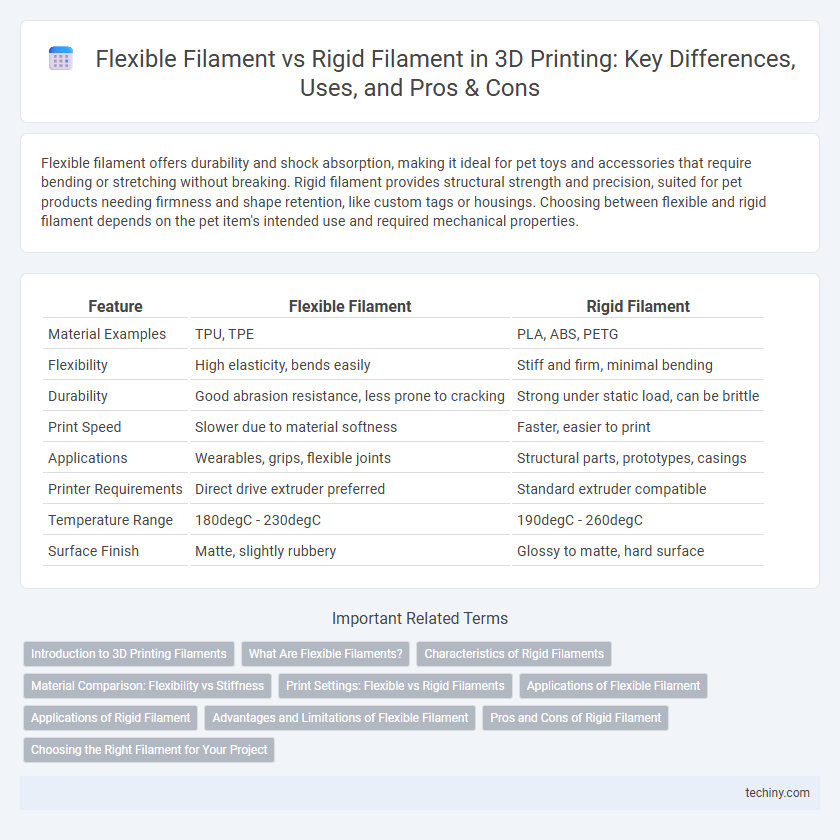Flexible filament offers durability and shock absorption, making it ideal for pet toys and accessories that require bending or stretching without breaking. Rigid filament provides structural strength and precision, suited for pet products needing firmness and shape retention, like custom tags or housings. Choosing between flexible and rigid filament depends on the pet item's intended use and required mechanical properties.
Table of Comparison
| Feature | Flexible Filament | Rigid Filament |
|---|---|---|
| Material Examples | TPU, TPE | PLA, ABS, PETG |
| Flexibility | High elasticity, bends easily | Stiff and firm, minimal bending |
| Durability | Good abrasion resistance, less prone to cracking | Strong under static load, can be brittle |
| Print Speed | Slower due to material softness | Faster, easier to print |
| Applications | Wearables, grips, flexible joints | Structural parts, prototypes, casings |
| Printer Requirements | Direct drive extruder preferred | Standard extruder compatible |
| Temperature Range | 180degC - 230degC | 190degC - 260degC |
| Surface Finish | Matte, slightly rubbery | Glossy to matte, hard surface |
Introduction to 3D Printing Filaments
3D printing filaments are essential materials that determine the quality and functionality of printed objects, with flexible and rigid filaments being two primary categories. Flexible filaments, such as TPU and TPE, offer elasticity and durability, ideal for applications requiring bendable, impact-resistant parts. Rigid filaments like PLA and ABS provide structural strength and precision, making them suitable for detailed models and mechanical components.
What Are Flexible Filaments?
Flexible filaments in 3D printing are materials designed to produce pliable, elastic, and bendable objects, typically made from thermoplastic elastomers such as TPU (thermoplastic polyurethane) or TPE (thermoplastic elastomer). These filaments offer high durability, abrasion resistance, and impact absorption, making them ideal for applications requiring elasticity like wearable devices, phone cases, and automotive parts. Unlike rigid filaments like PLA or ABS, flexible filaments require specialized printer settings, including slower print speeds and precise temperature control, to ensure optimal print quality.
Characteristics of Rigid Filaments
Rigid filaments in 3D printing, such as PLA, ABS, and PETG, are characterized by their high strength, durability, and structural integrity, making them ideal for functional prototypes and end-use parts. These materials exhibit low flexibility, offering excellent dimensional stability and resistance to deformation under stress or heat. Rigid filaments also typically provide superior surface finish and detail accuracy, which is essential for precise mechanical applications and components requiring a solid form.
Material Comparison: Flexibility vs Stiffness
Flexible filament, typically made from TPU or TPE, offers high elasticity and impact resistance, ideal for applications requiring bendability and shock absorption. Rigid filament, such as PLA or ABS, provides superior stiffness and structural strength, making it suitable for load-bearing or precision parts. The material choice depends on whether flexibility or rigidity is critical to the performance of the final 3D printed object.
Print Settings: Flexible vs Rigid Filaments
Flexible filaments require lower print speeds, reduced retraction settings, and higher nozzle temperatures to prevent clogging and ensure consistent extrusion, while rigid filaments typically print at higher speeds with more aggressive retraction and moderate nozzle temperatures. Bed adhesion techniques also differ; flexible filaments benefit from textured or coated build plates to minimize warping, whereas rigid filaments adhere well to standard glass or PEI surfaces. Optimizing print settings based on filament flexibility improves print quality, reduces stringing, and enhances layer bonding.
Applications of Flexible Filament
Flexible filament in 3D printing enables the creation of durable, bendable parts ideal for applications such as wearable devices, prosthetics, and soft robotics. Its elasticity allows for producing shock-absorbing components, flexible joints, and custom-fit grips that require high impact resistance. Popular materials like TPU and TPE offer superior flexibility compared to rigid filaments like PLA or ABS, expanding design possibilities in medical, automotive, and consumer product sectors.
Applications of Rigid Filament
Rigid filament excels in applications requiring high dimensional stability and structural integrity, such as prototyping mechanical parts, industrial tooling, and end-use components. Materials like PLA, ABS, and PETG offer excellent strength, heat resistance, and durability, making them ideal for load-bearing and precise functional parts. Its rigidity supports detailed prints with minimal warping, essential for automotive, aerospace, and consumer product manufacturing.
Advantages and Limitations of Flexible Filament
Flexible filament offers superior elasticity and impact resistance compared to rigid filament, making it ideal for applications requiring bendable, durable parts such as wearable devices, seals, and phone cases. Its limitations include more challenging print settings, slower print speeds, and potential difficulties with precise dimensional accuracy due to material stretch. Despite these constraints, flexible filament enables innovative design possibilities where rigidity would compromise functionality and comfort.
Pros and Cons of Rigid Filament
Rigid filament offers high strength, excellent dimensional stability, and superior surface finish, making it ideal for functional parts and detailed prototypes. However, its lack of flexibility can lead to brittleness and increased risk of cracking under stress or impact. Rigid materials such as PLA, ABS, and PETG are best suited for applications requiring durability and precision but may not perform well in flexible or shock-absorbing roles.
Choosing the Right Filament for Your Project
Flexible filament offers superior elasticity and durability, making it ideal for wearable items, phone cases, and parts requiring shock absorption. Rigid filament provides higher structural strength and precision, perfect for mechanical components, prototypes, and detailed models. Selecting the right filament depends on your project's functional requirements, such as flexibility needs, strength, and surface finish quality.
Flexible Filament vs Rigid Filament Infographic

 techiny.com
techiny.com